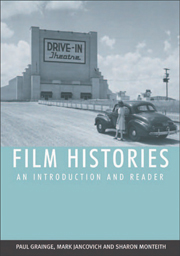Book contents
- Frontmatter
- Contents
- Preface
- Part I Film History from its Origins to 1945
- Part II Film History from 1946 to the Present
- 13 Postwar Challenges: National Regeneration, HUAC Investigations, Divestiture and Declining Audiences
- 14 The Politics of Polarisation: Affluence, Anxiety and the Cold War
- 15 Cinematic Spectacles and the Rise of the Independents
- 16 New Waves, Specialist Audiences and Adult Films
- 17 Radicalism, Revolution and Counter-Cinema
- 18 Modernism, Nostalgia and the Hollywood Renaissance
- 19 From Movie Brats to Movie Blockbusters
- 20 The Exhibitors Strike Back: Multiplexes, Video and the Rise of Home Cinema
- 21 Postmodernism, High Concept and Eighties Excess
- 22 Cults, Independents and ‘Guerrilla’ Filmmaking
- 23 From Cinemas to Theme Parks: Conglomeration, Synergy and Multimedia
- 24 Globalisation and the New Millennium
- Bibliography
- Copyright Acknowledgements
- Index
23 - From Cinemas to Theme Parks: Conglomeration, Synergy and Multimedia
from Part II - Film History from 1946 to the Present
Published online by Cambridge University Press: 05 August 2013
- Frontmatter
- Contents
- Preface
- Part I Film History from its Origins to 1945
- Part II Film History from 1946 to the Present
- 13 Postwar Challenges: National Regeneration, HUAC Investigations, Divestiture and Declining Audiences
- 14 The Politics of Polarisation: Affluence, Anxiety and the Cold War
- 15 Cinematic Spectacles and the Rise of the Independents
- 16 New Waves, Specialist Audiences and Adult Films
- 17 Radicalism, Revolution and Counter-Cinema
- 18 Modernism, Nostalgia and the Hollywood Renaissance
- 19 From Movie Brats to Movie Blockbusters
- 20 The Exhibitors Strike Back: Multiplexes, Video and the Rise of Home Cinema
- 21 Postmodernism, High Concept and Eighties Excess
- 22 Cults, Independents and ‘Guerrilla’ Filmmaking
- 23 From Cinemas to Theme Parks: Conglomeration, Synergy and Multimedia
- 24 Globalisation and the New Millennium
- Bibliography
- Copyright Acknowledgements
- Index
Summary
During the 1980s, nearly all the Hollywood majors became subsidiary divisions within giant corporations seeking to diversify their investments. While some film studios remained untouched by this emerging corporate pattern, a new burst of takeovers and buyouts in the mid- to late 1980s saw the remaining studios acquired, often by non-US buyers. In 1985, the News Corporation, owned by Australian publisher Rupert Murdoch, purchased Twentieth-Century Fox; in 1989, the Japanese electronics company Sony bought Columbia Pictures from Coca-Cola; and in 1990, Universal was acquired by Japan's Matsushita Electronic Industrial Company. Only Disney remained autonomous in corporate terms. Amidst this business activity was an emerging picture of consolidation in media industries. Gradually getting rid of non-film and media interests, conglomerates began to streamline their operations and consolidate their power around the core business of entertainment and communications.
One of the most significant examples of media conglomeration came in 1989 when the publishing company Time Inc. merged with Warner Communications Inc. in a $14 billion deal. Followed by subsequent mergers with Turner Broadcasting in 1996 and America Online in 2000, the market worth of the conglomerate had reached $96 billion by the start of 2000. It had combined stakes in publishing, cable, music, film, video, television, the Internet, professional sports teams, retail outlets, studios, cinemas and theme parks. Linking old media and new media, Time Warner was committed to the creative synergy of its multi-media investments and to ever-deepening global market expansion.
- Type
- Chapter
- Information
- Film HistoriesAn Introduction and Reader, pp. 529 - 549Publisher: Edinburgh University PressPrint publication year: 2007



